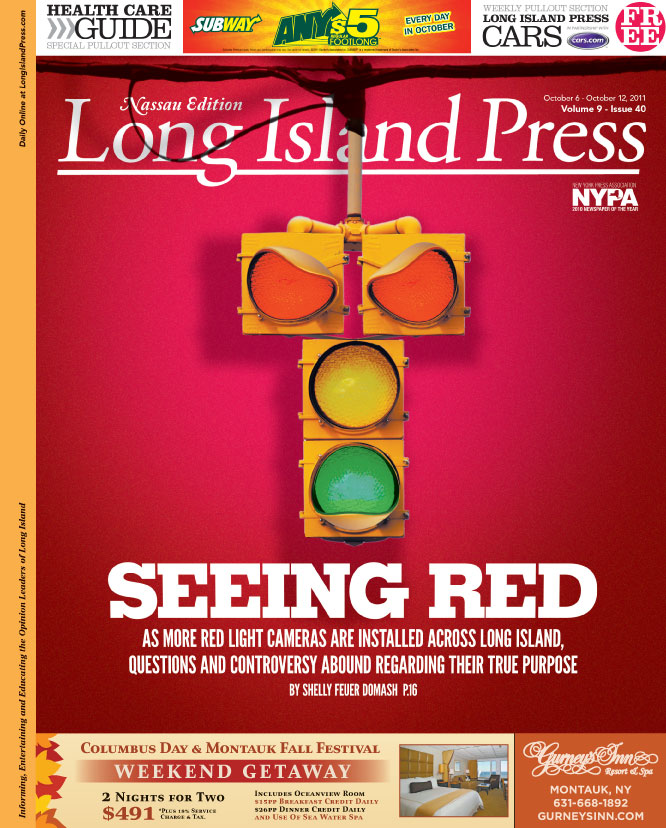
Nassau and Suffolk counties were granted the authority to begin installing the cameras under a pilot program authorized by the state legislature in 2009. They were both limited to 50 sites, and the cost of the summons was not to exceed $50. Since then, Nassau County has added a $15 surcharge and a $25 late fee. Suffolk has also added a $25 late charge. (Both note an additional $4 bank fee for payments made over the phone or online.)
Both counties then put out requests for proposals. Nassau County chose Scottsdale, Ariz.-based American Traffic Solutions (ATS) and Suffolk picked Fairfax, Va.-based Affiliated Computer Services (ACS).
The first camera was installed in Nassau on Aug. 6, 2009. By March 2011, all 50 camera sites were operational. Suffolk’s first camera site went live in June 2010; all its 50 locations were operational by April 2011.
According to Christopher Mistron, head of Nassau County Department of Public Works (DPW) Traffic Safety Board, Nassau currently has a total of 152 cameras at the 50 intersections it targeted. James Peterman, chief deputy commissioner of Suffolk’s DPW, says his county has 100 cameras at its 50 chosen corners.
As of Aug. 10, 2011, Suffolk had issued 210,141 citations, with approximately 3,000 of those contested. The courts found only 37 defendants not guilty. Nassau has issued more than 480,000 violations, with 1,884 hearings and 388 dismissed.
The cameras’ mechanics are simple. A high-resolution, high-speed digital camera is activated by sensors located at the intersections. They are designed to respond only when a vehicle is detected by the sensors after the light has turned red. The camera then snaps two photos: one of the car and one of the license plate. Tickets are issued for cars making left-hand turns while the traffic signal is red, going straight through a red light and making a right on red without a full stop.
Mistron, who returned Press requests for comment from Nassau County Executive Ed Mangano, says the program has been successful in increasing public safety.
Comparing the number of accidents for the year prior to the cameras’ installation with figures the year afterward, he says, there was a 15.53 percent yearly overall reduction in accidents, a 30.46 percent reduction in side-impact crashes, and a 16.5 percent reduction of roadway fatalities countywide from 2009 to 2010.
“The use of red light cameras has been successful in changing drivers’ behavior to recognize that red means stop,” he says. “Accidents have decreased. There has been a severity shift of accidents away from the higher-side impact, injury-producing accident. Prior to the cameras’ usage, side-impact accidents accounted for 36.07 percent of all accidents. After the installation, the percentage of all accidents is 29.69 percent.”
Mistron adds that making a left turn from the middle of an intersection will not automatically result in a ticket—a popular complaint from motorists.
“If you are at an intersection, possibly you and the car behind you can turn,” he says.
Nassau’s contract calls for ATS to make the initial observation for any violation. The company then “match[es] up the plate with the DMV records so the county knows who the car is registered to,” Mistron says, adding that ATS does not make the final determination of a violation.
The information is sent to the county’s traffic and parking violation bureau, where staff members review the images and videos to determine if a violation occurred. If so, says Mistron, “The vendor becomes our mail house, since we don’t have the mail capabilities within the county that could print and send tickets, provide the lock box, or location where the fines are collected. They take care of that for us. They have a flat leasing agreement; one ticket or a thousand, they get the same. That was determined and decided early on.”
The program has brought Nassau—and ATS—a windfall.
According to county documents, for the first full year of service in 2010, the revenue from these red-light cameras totaled $14,938,680.00. ATS made $4,406,523.14, giving Nassau a $10,532,156.86 profit. Records also show that the county is considering changing their agreement with ATS, looking at different ways to finance the cameras, including splitting all fees. Nassau is currently lobbying lawmakers in Albany to approve 50 more devices.
When Miston is asked where the more than $10 million in proceeds have gone, he says, “The Legislature had dedicated funds for social programs, youth board and health department.” A full “breakdown” and “detailed accounting” of these funds originally provided by Mangano’s Press Secretary Katie Grilli-Robles did not account for $2.5 million in 2010, nor for more than $2 million brought in the previous year. Shortly before press time, Grilli-Robles provided a subsequent breakdown that raises additional questions.
Although a request by the Press for revenues from Suffolk County’s red light camera program was still not fulfilled as of press time for this story, all expenses associated with the installation of the red light camera equipment (more than $10 million) have been paid by ACS, explains Suffolk’s James Peterman, and no county funds have been used except that of the time spent on the program by county employees. The vendor receives a share of the fines collected based upon the number of citations paid each month. Suffolk, too, is petitioning the state legislature for an additional 50 cameras.
The fees are calculated using a two-tier structure, continues Peterman. The first 90 citations paid per month per camera are considered Tier 1; the $50 fine split $37 for ACS and $13 for Suffolk. More than 90 citations per month per camera are considered Tier 2 citations, with the split $17 to ACS and $33 for Suffolk. All fees are deposited directly into a Suffolk County Treasurer’s account, and then ACS bills the county for its portion of the revenues, he explains. The vendor is responsible for the installation, operation and maintenance of the cameras. Each camera is remotely checked daily and physically inspected at least once a week by the vendor’s technicians, he adds.
Each recorded violation is reviewed by the staff of the Suffolk County District Attorney’s Office, says Peterman. Though none of the reviewers have law enforcement background, he explains, “New York State law does not require red light violation reviewers to have a law enforcement background. In Suffolk, as in many municipalities, including Nassau County, reviewers are fully trained civilian employees.”
Mistron insists that the goal of these cameras is to change the behavior of Long Island motorists.
“We want to reduce crashes and accidents,” he says. “The main thing is to change people’s behavior and basically to get people to understand that red means red.”
Critics, such as Jay Beeber, founder of the grassroots Safer Streets L.A.—whose motto is “Stop LA’s Red Light Camera Rip-Off”—agree to disagree with this assessment, pointing to a host of studies as evidence. Instead of installing the cash cow cameras, they say officials should be fixing problem intersections through engineering solutions, such as lengthening the time a traffic light is yellow, or amber.
“People who support [the cameras] say it will change driver behavior,” he tells the Press. “It does, and it does so in many cases in negative ways.”
Beeber and other red-light camera opponents allege that the number of rear-end accidents at those intersections actually jumped—some as high as 90 percent—after their installation. Critics also accuse ATS and ACS with a slew of unethical behavior, from creating fictitious and misleading pro-camera online groups and personas to lobbing threats and lawsuits against municipalities, officials and individuals who oppose their installation.





